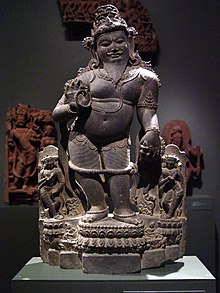
Back أدب سنغمي Arabic সঙ্গম সাহিত্য Bengali/Bangla Literatura sangam Catalan Sangam-Literatur German Literatura sangam Spanish ادبیات سنگام Persian Sangam-kirjallisuus Finnish Littérature tamoule classique French संगम साहित्य Hindi Letteratura Sangam Italian

The Sangam literature (Tamil: சங்க இலக்கியம், caṅka ilakkiyam) historically known as 'the poetry of the noble ones' (Tamil: சான்றோர் செய்யுள், Cāṉṟōr ceyyuḷ)[1] connotes the early classical Tamil literature and is the earliest known literature of South India. The Tamil tradition and legends link it to three legendary literary gatherings around Madurai and Kapāṭapuram: the first lasted over 4,440 years, the second over 3,700 years, and the third over 1,850 years.[2][3] Scholars consider this Tamil tradition-based chronology as ahistorical and mythical.[4] Most scholars suggest the historical Sangam literature era, also called the Sangam period, spanned from c. 300 BCE to 300 CE,[2][5][6] while others variously place this early classical Tamil literature period a bit later and more narrowly but all before 300 CE.[7][8][9] According to Kamil Zvelebil, a Tamil literature and history scholar, the most acceptable range for the Sangam literature is 100 BCE to 250 CE, based on the linguistic, prosodic and quasi-historic allusions within the texts and the colophons.[10]
The Sangam literature had fallen into oblivion for much of the second millennium of the common era, but were preserved by and rediscovered in the monasteries of Hinduism, near Kumbakonam, by colonial-era scholars in the late nineteenth century.[11][12] The rediscovered Sangam classical collection is largely a bardic corpus. It comprises an Urtext of oldest surviving Tamil grammar (Tolkappiyam), the Ettuttokai anthology (the "Eight Collections"), the Pathuppaattu anthology (the "Ten Songs").[13] The Tamil literature that followed the Sangam period – that is, after c. 250 CE but before c. 600 CE – is generally called the "post-Sangam" literature.[8]
This collection contains 2381 poems in Tamil composed by 473 poets, some 102 anonymous.[13][14] Of these, 16 poets account for about 50% of the known Sangam literature,[13] with Kapilar – the most prolific poet – alone contributing just little less than 10% of the entire corpus.[15] These poems vary between 3 and 782 lines long.[12] The bardic poetry of the Sangam era is largely about love (akam) and war (puram), with the exception of the shorter poems such as in Paripaatal which is more religious and praise Vishnu and Murugan.[2][16][17]
On their significance, Zvelebil quotes A. K. Ramanujan, "In their antiquity and in their contemporaneity, there is not much else in any Indian literature equal to these quiet and dramatic Tamil poems. In their values and stances, they represent a mature classical poetry: passion is balanced by courtesy, transparency by ironies and nuances of design, impersonality by vivid detail, austerity of line by richness of implication. These poems are not just the earliest evidence of the Tamil genius."[18] The Sangam literature also includes Buddhist and Jainist epics.[19]
- ^ K Kailasapathy (1968). Tamil Heroic Poetry. Clarendon Press. p. 1. ISBN 9780198154341.
- ^ a b c Upinder Singh (2008). A History of Ancient and Early Medieval India: From the Stone Age to the 12th Century. Pearson Education India. pp. 27–28. ISBN 978-81-317-1120-0.
- ^ Kamil Zvelebil 1973, pp. 45–49 with footnotes
- ^ Roma Chatterjee, ed. (2021). India: Society, Religion and Literature in Ancient and Medieval Periods (1st ed.). New Delhi: Government of India, Ministry of Information and Broadcasting. p. 73. ISBN 978-93-5409-122-3.
- ^ Nadarajah, Devapoopathy (1994). Love in Sanskrit and Tamil Literature: A Study of Characters and Nature, 200 B.C.-A.D. 500. Motilal Banarsidass Publ. ISBN 978-81-208-1215-4.
- ^ University, Vijaya Ramaswamy, Jawaharlal Nehru (25 August 2017). Historical Dictionary of the Tamils. Rowman & Littlefield. ISBN 978-1-5381-0686-0.
{{cite book}}: CS1 maint: multiple names: authors list (link) - ^ Hartmut Scharfe (1977). Grammatical Literature. Otto Harrassowitz Verlag. pp. 178–179. ISBN 978-3-447-01706-0.
- ^ a b Kamil Zvelebil (1992). Companion Studies to the History of Tamil Literature. BRILL Academic. pp. 12–13. ISBN 90-04-09365-6.
- ^ Kallidaikurichi Aiyah Nilakanta Sastri (1958). A history of South India from prehistoric times to the fall of Vijayanagar. Oxford University Press. pp. 110–112.
- ^ Kamil Zvelebil 1974, pp. 9–10 with footnotes.
- ^ Kamil Zvelebil 1974, pp. 7–8 with footnotes.
- ^ a b Takanobu Takahashi (1995). Tamil Love Poetry and Poetics. BRILL Academic. pp. 1–3 with footnotes. ISBN 90-04-10042-3.
- ^ a b c Kamil Zvelebil 1974, pp. 9–10.
- ^ George L. Hart III, The Poems of Ancient Tamil, U of California P, 1975.
- ^ Cite error: The named reference
Shelbywas invoked but never defined (see the help page). - ^ Kallidaikurichi Aiyah Nilakanta Sastri (1958). A history of South India from prehistoric times to the fall of Vijayanagar. Oxford University Press. pp. 110–119, 330–335.
- ^ Sangam Literature, Encyclopaedia Britannica (2011)
- ^ Kamil Zvelebil 1974, p. 47.
- ^ "Hinduism, Jainism and Buddhism in early Tamil History". Sanskriti - Hinduism and Indian Culture Website. 26 August 2015. Retrieved 23 August 2021.
© MMXXIII Rich X Search. We shall prevail. All rights reserved. Rich X Search